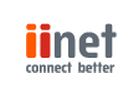IiNET
Appearance
 | |
| Type: | Public Company |
| Industry: | Telecommunications |
| Founded: | 1993 |
| Founder(s): | Michael Malone Michael O'Reilly |
| Headquarters: | Lvl 1, 502 Hay Street Subiaco, Western Australia 6008 |
| Country: | Australia |
| Businesses: | Netspace |
| Employees: | more than 2,000 |
| Revenue: | $473.8 million (2010) [1] |
| Website: | www.iinet.net.au |
| LinkedIn: | iiNet |
| Key People | |
| Michael Malone, CEO | |
iiNet is an the second largest Internet Service Provide (ISP) in Australia with more than 2000 employees. The company also provides broadband, telephony and Internet Protocol TV (IPTV) services for more than 1.3 million customers. [2]
Timeline[edit | edit source]
Below are important events in the history of the company: [3]
- 1993 - Michael Malone and Michael O'Reilly co-founded iiNet at Malone's home garage. It was the first dial-up internet access provider in Western Australia.
- 1995 - iiNet's business operations was transferred to Perth CBD to be able to provide services to an increasing number of customers. iiNet also joined other organizations and established WA Internet Association.
- 1996 - iiNet acquired Online Information Systems and Access Communications.
- 1998 - Fourteen (14) other small ISPs making the company the largest Tier 2 ISPs in Australia while second largest among Tier 1 ISP providers.
- 1999 - iiNet went public and it was listed in the Australian Stock Exchange. The company merged with Wantree and acquired other companies including Omen Internet, Networx, Nettrek and Infinite Data, MNS and Comtech, which made the company the second largest ISP in WA.
- 2000 - Broadband services were launched by the company including Cable Internet Access, Cityspan Wireless Internet Access and ADSL Internet Access.
- 2001 - iiNet launched Chime Communications,a telecommunications carrier and Jiva Online, which provides hosting services. Both are wholly-owned subsidiaries of the company.
- 2002 - The company received its ISO9001 certification.
- 2003 - The Network Operations Centre (NOC) was established by the company to monitor its network 24/7 as the company reached 200,000 subscribers. The company also acquired additional ISP companies including Country Netlink, Origin Internet, RuralNet, TasAccess, WebOne, Octa4 and ihug.
- 2004 - iiNet continued to expand and acquired FlowADSL, Froggy dialup, Wave and Virtual Communities doubling its customers to 400,000. The company also launched a National dial-up number in Australia and deployed its own infrastructure known as DSLAMS.
- 2005 - The company launched its next generation products and services such as iibroadband2, which offers super fast speeds at 8000 kbps and iiphone, an internet and phone service bundle offered a competitive price. iiNet sold its satellite business to Bordernet, an Australian company expert in satellite operations. On the other hand it acquired OzEmail, increasing its customers to 620,000. The company also introduced its oice Over Internet Protocol (VoIP) service.
- 2006 - Its Virtual Contact Centre (VCC) became operational and establish a partnership agreement with PowerTel, a telecommunications provider to offer wholesale ADSL2+ to other ISPs. It also sold ihug to Vodafone.
- 2007 - The company partnered with Apple to provide un-metered download to iTunes and won its line sharing dispute against Telstra.
- 2008 - The company signed a 15-year agreement with Pipe International to construct new cable infrastrutures from Australia to Guam and acquired Up'N'Away, a local ISP and Westnet, the third largest ISP in Australia.
- 2009 - iiNet submitted its defense against the copyright lawsuit filed by Hollywood studios. The company also abandoned its negotiations with Department of Broadband, Communications and the Digital Economy regarding the issue on filtering trial. The company partnered with OptiComm in launching its first lightening-fast Fibre-to-the-Home (FTTH) broadband services.
- 2010- The company won the copyright infringement case. The court ruled that iiNet did not authorize the infringement of copyrights commiteed by iiNet users.
References[edit | edit source]
{[reflist}}

